Printmaking Without Limits

A wide range of printmaking techniques — from monotypes and silkscreens to woodcut and solar plate prints — are on view in the current exhibition at the Higgins Gallery in the Tilden Arts Center at Cape Cod Community College (2240 Iyannough Road, West Barnstable).

Curated by gallery director Nathalie Ferrier, “Limitless … Ideas” features work by nearly two dozen Cape Cod and regional artists, including several who work and regularly exhibit on the Outer Cape. Many of the artists in the show are members of the Printmakers of Cape Cod, which was organized in 1976 to “encourage, assist, and promote printmaking on Cape Cod as well as to provide educational opportunities for new printmakers, collectors, and others interested in original prints,” according to a statement on the group’s website.
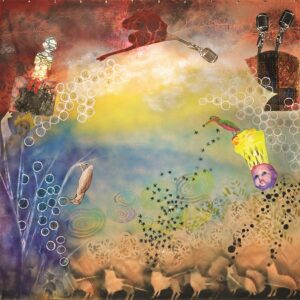
Several artists incorporate multiple printmaking techniques in a single work. Vicky Tomayko’s Ecological Story includes monoprint, lithography, and silkscreen, while Sarah Riley and Deb Mell use collage elements to a playfully surreal effect in A History of Water. Karleen Loughran uses monotype and solar plate printing to create works marked by an artfully controlled chaos, and black-and-white prints by Ann Guiliani, Adrian Tio, and Alan Trugman demonstrate the strong contrasts and expressive power of more straightforward printing techniques.
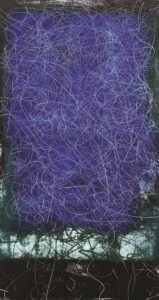
Other artists in the show include Joan Appel, Diana Carns, Mary Doering, Barbara Ford Doyle, Joe Fattori, Alice Galick, Ronni Komarow, Leslie Kramer, Jane Lincoln, Andrea Moore, Liz Perry, Alyssa Ringler, Sara David Ringler, Cecilia Rossey, Robert Scott, and Joyce Zavorskas.
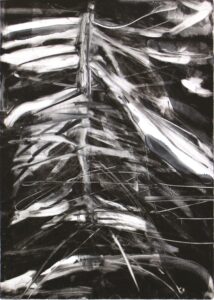
The exhibition is on view until Nov. 9, and admission to the gallery is free. See capecod.edu/higgins for information and an exhibition preview
Provincetown Woodcuts Bring Collectors at New York Auction
Several white-line woodcut prints by Provincetown artists fetched high prices at the Phillips Auction House in New York City last week, with a few items going for more than $30,000.
Phillips’s October Editions sale included 30 lots with Provincetown woodcut prints by 19 different artists, 16 of them women. The white-line woodcut was a specialty of a collective of Provincetown artists who pioneered the technique in 1915 and subsequently subtly changed the artistic landscape of the Northeast. The prints are seascapes; docile scenes of people sewing, rowing, walking, and lounging; still lifes; portraits of solitude and company — visions of busy towns made quiet by the simplicity of the form.
The prints, each made with a single reusable wood block and watercolor paints, feel more personal than other forms of printing such as lithography. The white lines that divide the colors and shapes in the prints, made by the paintless carved lines in the wood, give the pieces an easy, truthful feeling, as if the people, trees, and boats might at any moment begin to move.
The auction featured pieces by a core group of artists who became collectively known as the Provincetown Printers. Artists who drew special interest before the sale, said the auction house’s Jason Osborne, were B.J.O. Nordfeldt (1878-1955) and Blanche Lazzell (1878-1956). Sail Boat, by Lazzell, a print that seems to glow with warmth, had the highest presale estimated price: $20,000 to $40,000. It sold for $38,100, including the buyer’s premium.
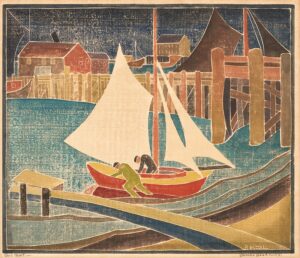
Lazzell’s print Barn in the Dunes, which had been estimated at $9,000 to $12,000, sold for $33,020. Nordfeldt’s Wash Day, a piece bathed in pale light, sold for $30,480 against an estimate of $5,000 to $7,000. The Silva Sisters by Ada Gilmore Chaffee (1883-1955), estimated at $4,000 to $6,000, sold for $25,400.
Bidding at that level, said Osborne, is exceptional and a sign of the importance of the works despite their often being “overlooked and underappreciated.” In an especially exciting series of bids, the white-line print Sewing by Ethel Mars (1876-1959), which was estimated at $1,500 to $2,500, sold with premium for $33,020 to the Museum of Fine Arts, Boston.
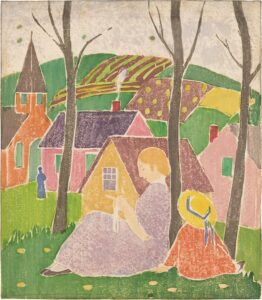
“We had hoped to bring the prints into a younger collecting crowd,” said Osborne, “because they’re just so cool and great.” That didn’t happen much, he added, but his hopes are still high for the future.
Phillips acquired the prints from a collector in Maryland, Osborne said. “It’s not that often that we get collectors who are so dedicated to a niche movement.” —Dorothea Samaha
Outer Cape Art Collective at the Commons
At the start of the pandemic in March 2020, Laura Shabott, like many educators, had to modify her teaching to go online. Although many bemoaned Zoom classrooms, for Shabott and the group of students she taught, those classes became a life-changing experience.
Shabott and Alana Barrett, a recent college graduate from Miami, worked primarily with people turning to art as a second career. What emerged was a group of peers embracing art as a full-time vocation who provided each other with support and encouragement.
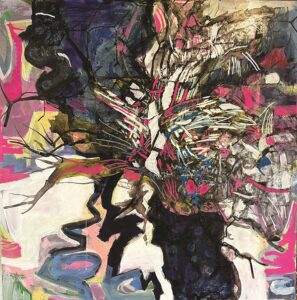
The group has since formed the Outer Cape Art Collective. Its inaugural exhibition, “Prompted!,” features work by the 21 members and is on display at the Provincetown Commons (46 Bradford St.) through Sunday, Nov. 12 with an opening reception on Friday, Nov. 3 from 5 to 7 p.m.
“Older people or people going into art as a second or third career, are often invisible,” says Shabott, a Provincetown-based artist who herself came back to painting in 2015 after 23 years away. “I saw them as very visible. They said they wanted to be full-time artists, and I taught them as if they were in art school.”
The group took online courses in art history with open studios, group critiques, and prompts. Shabott used the legacy of Provincetown artists and their teaching methods as starting points for many of her lessons. As a result, much of the work in the exhibition pays homage to the Provincetown traditions of figuration and abstraction.
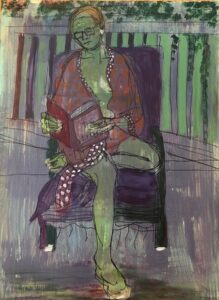
Laura Frader has two works in the exhibition, one inspired by Helen Frankenthaler’s experiments in using raw pigment on unprimed canvas and the other rooted in Hans Hofmann’s method of working from the figure to explore dynamics of “push and pull.” Frader joined the courses after a career as a history professor.
“I got back into an artistic practice I had left behind for almost 25 years,” says Frader, who credits the classes with stretching her beyond her comfort zone and allowing her to learn about new materials and new techniques. Her Frankenthaler-inspired painting, Sunset, Wellfleet, came about after reading Ninth Street Women with the group — a book about five abstract expressionists. The spirit of abstract expressionism hovers over the exhibition as a whole, reflected in the exploratory and experimental use of materials.
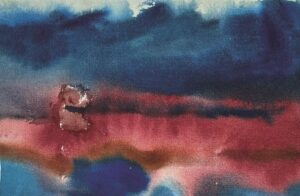
The classes are now over, and the show functions as both a moment of closure and a starting point. No longer students, the artists are spreading their wings and moving in new directions. “They grew together during the pandemic and really evolved as a collective almost organically,” says Shabott. “This is a reflection of what grew.” —Abraham Storer



